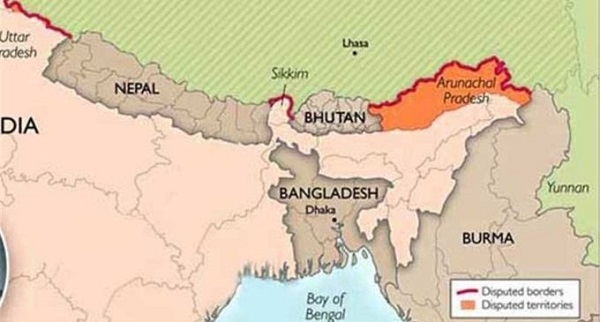Dare China include Arunachal in its updated map?
Total Views |
-Anjali Ankad
Restamping its footprint in India, this time in the midst of coronavirus, China has included some part of Arunachal Pradesh within its international boundaries as revealed by the latest version of Sky Map. Sky Map is China’s authority on digital maps that is a unit directly coming under the National Surveying and Mapping Geographic Information Bureau of China's capital Beijing.
The matter came to light after the Sky Map users realized that it has modernized China's map with few additional national borders, including Arunachal Pradesh. China has been strengthening its interference in India. It is in the last week that India had confirmed there were movements of seven to eight People's Liberation Army Navy warships and a Chinese aircraft in the Indian Ocean region.

Arunachal Pradesh was part of British India in 1913-14 and formally included in India when the McMohan Line was established as the border between India and Tibet in 1938. However, China blatantly continues to consider Arunachal Pradesh a part of Tibet, which it occupied in 1951. Based on the 1989 edition of the Sky Map of its national borders, since then China has successfully solved its border issues with Russia and Central Asian countries, however, none of them have been reflected in the map.
However, as per a DW report in Chinese, some users noticed it upgraded the geographic information at the county level. "The county boundaries of some counties clearly transcend the red color marked 1989 edition of the national border, especially in Tibet area bordering Bhutan and India,” the report said.
On the other hand, China has already claimed its sovereignty over Tibet though Chayu, Medog, and Cuona counties are divided by the McMahon Line with the northern parts in China and the southern parts in India. Nonetheless, it has claimed the counties bordering India and Bhutan from east to west — Chayu county, Medog county of Linzhi city, Cuona county, Luoza county of Shannan city, Kangma county, Yadong county of Xigaze city are part of China.
The report further added, “Longzi County in Shannan City does not theoretically border India, but the McMahon Line runs through the county from southwest to northeast, with Chinese control in the west and Indian control in the east.” However, China flagrantly calls the Indian area and part of Chayu county, Motuo county of Nyingchi city and Longzi county and Cuona county of Shannan City, 'South Tibet'.
As per the updated Sky Map, “the southern boundary of Chayu county is roughly the same as the boundary in 1989, the southern part of Motuo county has contracted northward, and the southern boundary of Cuona county also roughly coincides with the boundary in 1989. The Longzi county does not border India at all, as Beijing advocates. Cuona county of Shannan city not only borders with India but also borders with Bhutan.”
China-Bhutan border dispute area, Mulasading, is located in Cuona County-south of the McMahon Line. Mulasading originally belonged to Tibet and was managed by the Tawang Temple. In 1949, India and Bhutan signed the Permanent Peace and Friendship Agreement to transfer Mulasading to Bhutan. In the latest Sky Map, the border of Cuona County in the Mulasading region is south of the 1989 edition of the national border.
“In addition to Tibet, the borders of Tashkurgan County in the Kashgar region of Xinjiang have also changed. The northwestern part of the border is more than the 1989 edition. According to the 2011 border agreement between China and Tajikistan, this extra part is 1,158 square kilometers east of the Sarekole Mountains,” the report added. China occupies India’s Aksai Chin, around 37,000 sq km uninhabited high-altitude desert part of the former state of Jammu and Kashmir, bordering China’s Xinjiang province.

